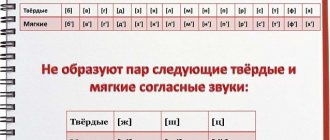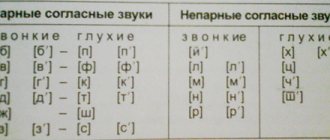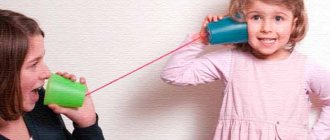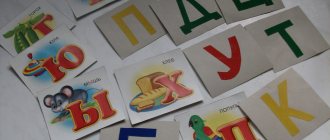Differentiation of affricates
Differentiation of sounds is a stage in correctional work with children on the formation of correct sound pronunciation, which is aimed at the ability to distinguish a certain sound from those that are similar in sound or in the method and place of formation.
Violation of phoneme differentiation manifests itself in the failure to assimilate letters and in the replacement of phonetically similar sounds when reading.
The differentiation of sounds in speech pathologists is carried out based on analyzers: speech-auditory, visual, speech-motor, kinesthetic. The use of these analyzers is determined by the nature of the violation.
For many speech pathologists, substitutions are caused by unclear phonemic processes and ideas about sounds. For the majority, the leading disorder is auditory differentiation. Therefore, the speech therapist begins work on differentiating sounds by relying on more intact visual perception, kinesthetic and tactile sensations, which we receive from the organs of articulation during the pronunciation of sounds.
The use of kinesthesia in differentiating affricates often requires preliminary work on the development and clarification of kinesthetic sensations based on the child’s tactile and visual sensations. The ability of kinesthetic discrimination is developed in exercises to determine the position of various speech organs (lips, tongue, vocal folds) during the pronunciation of speech sounds. Preliminary work on the development of kinesthetic sensations prepares children for auditory differentiation of speech sounds. In speech therapy work, it is necessary to take into account that improving the auditory discrimination of sounds will be more successful if it is carried out in close connection with the development of phonemic analysis and synthesis. The more accurately a child represents the sound structure of a word, the place of each sound in a word, the more clearly he determines the nature of the sound, the more correctly he differentiates the sounds of speech. The development of the phonemic analysis function thus contributes to the improvement of sound pronunciation differentiation.
Quite common interchanges include mixing affricates: [ts] - [h], [h] - [sch].
There are several reasons for the occurrence of violations of the pronunciation of the sounds [h] and [sch]. The first is the common component of these sounds, barely distinguishable by ear: the sound [w], which is included in both the sound [h] and the sound [sch]. The second is a barely perceptible upward movement of the tip of the tongue and touching the lateral teeth when pronouncing the sound [h].
The sounds [ch] and [ts] are stop sounds, each of these sounds is formed by merging two sounds: for the sound [h] it is [t + w], and for the sound [ts] it is [t + s].
By mixing these sounds, children simply do not feel the difference in pronunciation, which leads to the fact that instead of two sounds the child pronounces only one.
One of the main reasons for such disorders lies in impaired or decreased hearing, which prevents the discrimination of sounds in spontaneous speech (phonemic perception). The reason may also lie in impaired mobility of the tongue, in an incorrect bite or set of teeth. Typically, in such cases, the child knows how to pronounce sounds correctly, but cannot pronounce them without dental or orthodontic treatment.
Differentiation of specific pairs of mixed sounds includes two stages:
- a preliminary stage of work on each of the mixed sounds;
- the stage of auditory and pronunciation differentiation of mixed sounds.
At the first stage, the pronunciation and auditory image of each of the mixed sounds is sequentially refined. The work is carried out according to the following plan:
1. Clarification of sound articulation based on visual, auditory, tactile perception, and kinesthetic sensations.
For example, when clarifying the correct articulation of the sound ts, it is necessary to pay attention to its pronunciation: the sound [ts] is formed as a result of the rapid fusion of the sounds [t] and [s]. When pronouncing the sound [ts], the lips are parted in a smile, the teeth are closed or brought together (the teeth open when pronouncing the sound [ts] in straight syllables (tsa, tso...)), the tip of the tongue first rests on the lower incisors (approximately as for the sound [s] ): the tongue is concave and raised. The anterior part of the back of the tongue forms a closure with the palate (near the alveoli). The tongue is spread wide, the lateral edges are tense. When exhalation occurs, the front part of the tongue opens with the palate, the tip of the tongue bounces off the lower incisors. Using tactile sensation, it is clarified that when pronouncing this sound, raising your palm to your lips, you can feel a moderate push of a cold air stream; the vocal folds do not tremble. The sound [ts] is hard, dull.
The sound [h] is formed by sequentially pronouncing the sounds [t'] and [uh]. When pronouncing the sound [h], two articulations change: first, the tip of the tongue is lowered and touches the lower incisors. The front part of the back of the tongue is pressed against the upper incisors or alveoli. The middle part of the back of the tongue is curved towards the hard palate. At the next moment, the bow breaks, and the front edge of the tongue rebounds to a position corresponding to the articulation of the sound [ш]. The boundary between the elements of articulation is not perceptible by ear. The lips are pushed forward and rounded, the velum is raised, closing the passage into the nasal cavity, the vocal cords are open. Exhalation is performed with a sharp push of a warm stream of air.
The sound [sch] is an extended (long) soft hissing sound: [sh'-sh'-sh']. When pronouncing the sound [ш]: the lips are extended forward and rounded; the tongue is wide, raised to the upper alveoli, the tip of the tongue is free, the lateral edges of the tongue are pressed against the molars, the front part of the back of the tongue bends, the middle part of the tongue is raised to the hard palate, the back part is lowered and moved forward; a strong, warm air stream passes through the middle of the tongue through two slits: between the middle part of the back of the tongue and the hard palate and between the tip of the tongue and the front teeth; the velum is raised; vocal cords are open.
2. Isolation of sound against the background of a syllable. To do this, it is necessary to teach children to isolate the sound from a syllable by ear and in pronunciation, to distinguish between syllables with and without a given sound. So, a speech therapist names syllables that include, for example, the sound ts and those that do not (da, tsa, vo, ny, tsy, lu, tso, tsu). Children must raise a flag or letter if the sound [ts] is heard in a syllable.
3. Formation of the ability to determine the presence of sound in a word. The speech therapist suggests words that include this sound and do not have it. Words with sounds that are similar acoustically and are mixed in pronunciation are excluded.
To determine the presence of a sound in a word, the following exercises are offered:
- Raise the corresponding letter to the given sound.
- Name the pictures, select from them those whose names contain the given sound. Pictures for mixed sounds are not included. For example, at the first stage of differentiation of the sounds ts and ch, words with the sound ch and other similar sounds are excluded. Example pictures: hare, father, onion, lollipop, heron, desk, shovel, chicken, flower.
- Match the given letter with pictures whose names have the corresponding sound.
Pictures whose names contain phonetically similar sounds are not offered. The pictures are not named. This task is more complex than the previous one, since when performing it the child does not rely on the auditory perception of sound or its articulation, but on ideas about it. - Come up with words that include the sound corresponding to the given letter.
- Divide the page into two parts. Write a letter on the left, put a dash on the right. The speech therapist pronounces various words. If a student hears a word with a given sound, then he must draw a circle (or write the word) under the letter, i.e. left. If the word does not contain the required sound, then the circle is placed (or the word is written) on the right.
4. Determining the place of a sound in a word: at the beginning, in the middle, at the end of the word, after what sound, before what sound.
5. Isolating a word with a given sound from a sentence. For example, the task is given to identify words from a sentence that include a given sound. Each of the mixed sounds is worked out according to the specified plan.
At the second stage, a comparison of specific mixed sounds is carried out in pronunciation and auditory terms. Differentiation of sounds is carried out in the same sequence as the work to clarify the auditory and pronunciation characteristics of each sound, but due to the fact that the main goal of this stage is to distinguish sounds, speech material should include words with mixed sounds.
To differentiate sounds, the following types of entertaining games and exercises are offered:
1. “Catch the sound in your palms” Clap your hands if you hear the sound [h]. The speech therapist first pronounces the sounds [ch, ts, ch, ts, ts, ch], then the syllables: CHA, TSO, CA, CHO, CHA, CA, CHU, TSU and, finally, the words: heron, flower, kidney, seagull, chicken, mail, cucumber, kalach.
2. “Two ranks” Children should arrange the pictures on the desk so that on one side there are pictures for the sound [CH], and on the other, for the sound [SH].
3. “Sound Eater” The speech therapist shows the children one picture at a time and names them, omitting the last sound, because this sound was swallowed by the old man Sound Eater, for example: vra_, le_, gra_, lu_, pla__, etc. The child repeats the entire word and then pronounces the sound that is heard at the end of the word.
4. “Insert the missing sound.” The speech therapist pronounces the word, but instead of the given sound he claps his hands. Children must replace this non-speech sound with a speech sound [ch] or [sch]. For example: seagull - cotton - aika, borscht - boron - cotton.
5. “Additions” Prompt the last syllable with the sounds [h] or [sch]: - add a syllable - cha- or -sha-: ku..., gu..., pi.., yes..., pu...., doby..., ro ..., light... ; - add a syllable - chi- or -schi-: meet..., pla.., back..., re..., me.., hwo.... ; - add a syllable - chik- or -schik-: ban.., pla..., zay.., pon..., treasures.., mal..., dances..;
6. “Cryptographers” I name the word, and on your desks you lay out the letters corresponding to the sounds Ch or Shch that you will hear in this word. A drawing of the letters on the desks: Shch Ch, Ch, Ch, Shch.
7. “Radio Operators” The radio on the ship is broken, and the brave captain cannot receive or transmit call signs to the ground. Repeat after me in turn what you hear, and your fingers of both hands move the “walkie-talkie buttons” on the table. (The fingers work as if playing the piano.)
| H – C | Ch - Sh | Ch – Sh – C | |
| Scha - sch - sch - sch - sch - sch - sch - sch sch - chu - chu che - sch - sch - ach - ach och - sch - clean - ich - ich esch - esch - ech sch - uch - sch ach – och – ush | cha-tsa - cha cho-tso - tso chu-chu - tsu chi-tsy - chi che-tse - tsetsy-chi - chi ach-ats -ach ech-ets - ets ots-och - ots uts-uch - uch yat-yat-yat | tsa-cha-scha tsy-chi-schi scho-cho-tso sche-che-tse ats-ach-asch yats-yach-yash scho-ach-ats yash-yach-yats tso-cho-scho tse-che-sche chu-chu-tsu | ots-och-osch its-ich-isch osh-och-ots isch-ich-its tsu-chu-schu-cha-tsa schi-chi-cy uc-uch-usch ech-ech-yet ush-uch-uts yet |
8. Game “Broken Phone” If you hear the correct name of the picture on the phone, raise the green circle, if the picture is named incorrectly, raise the red circle: MYASCH, BALL, HOOP, HOOP, CHUCK, PIKE
9. Color and name only the pictures whose names contain the sound [у].
10. Match the pictures with the letter h and sq.
11. Find the letters ь, ч, ц and color them with the appropriate pencils.
ts ch u ch n n p ch n lu h ts sh c i sch y p sch w and y q s sh q p sh y and h cl ch w q sch q nc q s sch p ts u ch u ch u shp ts w s ch s s s s s s s s s s s s s s s s s s s s s s s s s s sch ts w g w sh sh n pu ts sh p sch n sch w n w w sch sh n pi sch
12. Write letters on each other’s palms, on each other’s backs, guess which letter is written (dermalexy technique).
13. Reading syllables with the letters ch, shch:
sha-sha sho-scho shu-schu ash-ash osh-osh ush-ush shi-schi she-sche-scho ish-sche es-esch-esch
14. Write words with w and shch in two columns: ..uka, ..elchok, jug..in, pry..ik, bro..ka, kro..it, ..orokh, ..epka, .. epotka, pi..it, ka..a, pla.., mountain..ina, gr..u, turn..at, ..elk, za..itnik, ver..ina.
15. Reading and writing the letters ch, c, sch in the words: sheep—heap—thick chain—whose—crack face—shoulder—still virgin soil—four—bristles catch—clearly—sliver heron—seagull—bloodhound circus—teal—shield sheep — melon — borscht cement — case — goldfinch
17. Reading and writing the letters ch, ts, shch in sentences. The boy caught a lizard. A she-wolf is prowling in the forest. The rooks' chicks are squeaking. The puppy is fiddling around in the closet. Birds are chirping in the grove. Hares gnaw bark in the thicket. Birds are looking for worms. The chicken is looking for bugs. The hen is lost and is looking for chicks. The bug drags the mitten. A bird of prey carries prey. There are planks and wood chips on the street. The frost grew stronger and stung my cheeks and fingers. The rays of the sun shine through the clouds. The father caught a pike with a fishing rod. A boy drags a ball outside. The puppy is chasing a bird. The seller showed a black cloak. A sparkling stream gurgles and runs down the street. The clouds are rushing, the clouds are swirling; The invisible moon illuminates the flying snow.
18. The following encryption: read the phrases, insert the missing letters Ch or Sh. Copy the phrases, highlighting the letters and sounds: Mo...ny traction,...at...ka on the hook...ke, about...naya...etina, at...epki in the...ike , bird...y...fuck, ve....and for u...a...ikhsya, mo...yonaya ulo...ka,...ie...iki on the floor...ke, Ludo...kin pla..., hi...nick in...a...fucking, ... erd...noe room, fan...er in...or...e
19. Fill in the missing letters Ch - C - Shch: Grove In spring, many birds flew to the grove. The most noticeable of all is the game and the star. __black and agile. The birds are busy in __a__e. Tre__at su__ya and veto__ki. It's the birds who make their living. The sun is shining brightly. Fun __fucking birds. Birds hatch chicks. Chicks need food - beetles, worms, geese. Pti__s and__ut pi__u not only in Ro__e. They also fly to the fields.
20. Read and retell the text. Seafaring crustacean After swimming, we cleaned the ship of shells and grass. There are so many of them on the bottom that they prevent the ship from sailing. A whole beard drags along the bottom. They cleaned it with what: a scraper, brushes and even a chisel - the crustaceans clung so tightly to the bottom.
They cleaned and cleaned, and the boatswain said: “We’ll grow again in the sea.” Crustaceans and snails are just looking for something to settle on. Finally they cleaned the bottom and started painting. And the boatswain made me hit a sea acorn. An acorn is a white shell with a lid and a crustacean inside. I started to knock it down with a scraper, but the shell didn’t come off. Inside, the crustacean is slurping, only the lid is slightly opened. “Eh,” I think, “let the seafaring crustacean remain. It clings tightly to the bottom and floats with us.” At sea, I thought about the crustacean: how much more he would have to experience while swimming. (According to G. Snegirev)
Literature
1. Speech therapist's reference book \ M.A.
Povalyaeva. – Ed. 5th. – Rostov n\d: Phoenix, 2006. – 445 p. 2. A.S. Gerasimova, O. S. Zhuchkova, V.G. Kuznetsova A unique method for developing the speech of a preschooler. - St. Petersburg: Publishing House "Neva" M.: OLMA-PRESS", 2002. - 688 p. 3. Correction of sounds [Ш] and [Ч]: individual lessons with children 5-7 years old\auth. – comp. E.A. Lapp. – Volgograd: Teacher, 2011. – 95 p. Author of the material: Budchenko Anna Aleksandrovna
LOGOPEDARY.RU - Differentiation of sounds [h] - [ts]. — LOGOPED.RU
Differentiation of sounds [Ч]—[Ц].You can begin to differentiate only after the sound has been delivered and automated. Pronounce (read) syllables. Mystery. There is a prickly flower on the window, looking beyond the outskirts. You better not touch him - the pricking hurts very much. (Cactus) Cautious. The thunderous thunder fell silent over the forest Three whole hours ago. But mushrooms, just in case, look out from under the umbrellas. (V. Orlov) Learn a poem by heart. Bee. A bee sits on a flower, How small it is! Our bee collects sweet juice in its proboscis. And the flower sways - She doesn’t like it. (K. Bykova) Pronounce (read) and retell the text. The first worm. The hen took the chicks to teach them how to look for worms. “There are all kinds of worms, and they are not easy to find,” the chicken taught. Eight chickens listened to the hen. But the two chickens did not listen. They rushed to look for the worm. I really wanted to be the first to find the worm. One chicken tripped over something and fell. “This is the worm,” shouted the chicken. “We’ll dig it up and take it to these fools.” After much work, the chickens finally dug up the worm and took the worm to their brothers. “That’s what a worm is,” said the chickens and threw ... a nail. (According to M. Petrov) We wish you success! |
www.logoped.ru





